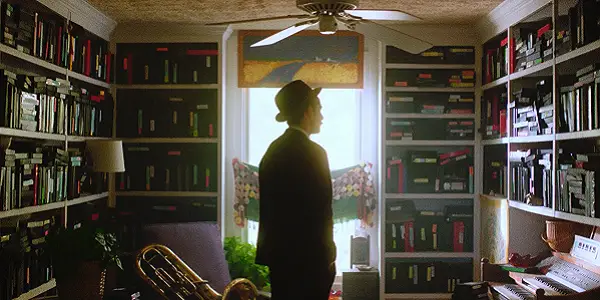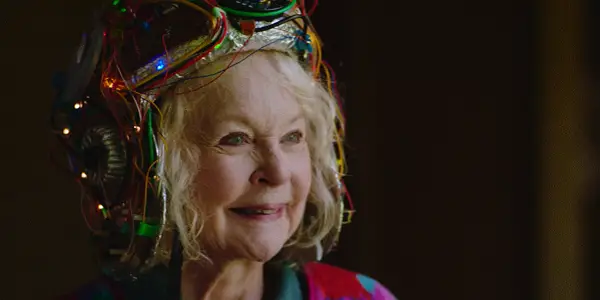STRAWBERRY MANSION: When Taxman Meets Sandman

Lee Jutton has directed short films starring a killer toaster,…
In a world where it becomes more and more clear by the day that capitalism is king, it really isn’t that outrageous to imagine the powers that be finding a way to tax our dreams. Such is the premise of Strawberry Mansion, written and directed by Kentucker Audley and Albert Birney. A deeply weird and visually striking journey into the subconscious, Strawberry Mansion packs more imagination into one scene than many films with far bigger budgets do in their entire running time. And while that doesn’t mean everything about it works, it does mean you won’t be able to tear your eyes away while watching it.
Penny for Your Thoughts
It’s the year 2035. James Preble (Audley) has been working for the federal government as a tax auditor for years. However, his job is focused less on reviewing people’s paperwork and more on digging through their minds. In the strange new world of Strawberry Mansion, people record their dreams upon waking and scan them for elements upon which taxes are owed. If the taxes remain unpaid, auditors like Preble show up to collect. (Preble’s own dreams are populated by product placement for a fried chicken chain and an almost aggressively helpful man called Buddy.)

One day, Preble heads to the home of an elderly eccentric named Bella Isadora (Penny Fuller) who owes unpaid taxes on her dreams. Bella has refused to convert her dreams to the new digital format; her home is filled with stacks of VHS tapes, chronicling thousands of dreams from over the years of Bella’s lengthy life. Despite the numerous challenges presented by this analog format, Preble settles in and gets to work. However, this audit is anything but straightforward. For one thing, after repeatedly encountering Bella’s younger self (Grace Glowicki) in the world of the dreams, Preble starts to fall in love with her. For another, Bella is sitting on some family secrets that put Preble in danger as he gets closer to uncovering them.
Dream a Little Dream
Chock full of magical practical effects that mirror Bella’s refusal to engage with the digital world—including a delightful, light-festooned helmet that the elderly woman says is designed to block ads from being inserted into one’s subconscious — Strawberry Mansion is a joy to look at. The film was shot digitally and converted to 16mm in post-production, giving every frame a pleasant, vintage texture that one doesn’t often see in modern movies. Indeed, from the stop-motion skeleton (courtesy of animator Lawrence Becker) that climbs out of a grave to play music to the grass-covered creature that ambles through the landscapes of Bella’s dreams, the entirety of Strawberry Mansion feels reminiscent of the charming fantasies of one’s childhood.

Like a dream that grows foggy and unclear upon awakening, the plot of Strawberry Mansion grows increasingly nonsensical as it progresses; as you try to unravel the film’s mysteries, your head ends up spinning even more than Preble’s. It’s better to just give up on trying to understand what is going on — uh, what’s that blue demon doing there? — and go with the flow, letting yourself get carried away by the pretty imagery and surreal story.
Really, the biggest weakness of Strawberry Mansion is that some of the performances are uncomfortably stiff, giving you the feeling that the actors are just as confused about what’s going on as we are. Exceptions must be made, however, for the actresses who together embody Bella; both Fuller, as her older incarnation, and Glowicki, as the younger one, have warm, bubbly screen presences that are guaranteed to win you over. It’s no wonder that the deeper Preble digs into Bella’s dreams, the more he falls in love with her and becomes convinced that she’s right: the constant surveillance and monetization of our modern world mean one has to escape from its influence in order to find genuine happiness.
Conclusion
A crazy, colorful film that echoes the work of Terry Gilliam and Ray Harryhausen, Strawberry Mansion is worth a visit, even if at some points it seems on the verge of collapsing around you.
What do you think? What are some of your favorite stories about dreams? Share your thoughts in the comments below.
Strawberry Mansion opens in select theaters in the U.S. on February 18, 2022.
Watch Strawberry Mansion
Does content like this matter to you?
Become a Member and support film journalism. Unlock access to all of Film Inquiry`s great articles. Join a community of like-minded readers who are passionate about cinema - get access to our private members Network, give back to independent filmmakers, and more.
Lee Jutton has directed short films starring a killer toaster, a killer Christmas tree, and a not-killer leopard. Her writing has appeared in publications such as Film School Rejects, Bitch: A Feminist Response to Pop Culture, Bitch Flicks, TV Fanatic, and Just Press Play. When not watching, making, or writing about films, she can usually be found on Twitter obsessing over soccer, BTS, and her cat.













